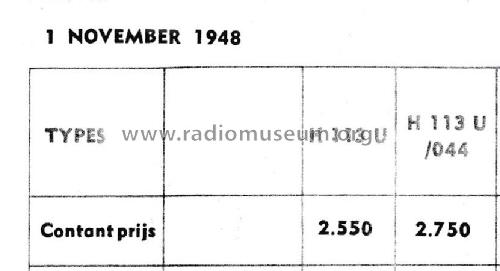Aristona / Pygmée H113U /?, H113U /044
NSF (Nederlandsche Seintoestellen Fabriek); Leuven
- País
- Bélgica
- Fabricante / Marca
- NSF (Nederlandsche Seintoestellen Fabriek); Leuven
- Año
- 1948/1949
- Categoría
- Radio - o Sintonizador pasado WW2
- Radiomuseum.org ID
- 277418
- Numero de valvulas
- 0
- Principio principal
- Superheterodino en general; ZF/IF 452 kHz; 2 Etapas de AF
- Número de circuitos sintonía
- 6 Circuíto(s) AM
- Gama de ondas
- OM, OL y OC
- Tensión de funcionamiento
- Red: Aparato AC/DC. / (110) 125; (200) 220 Volt
- Altavoz
- Altavoz dinámico (de imán permanente) / Ø 13 cm = 5.1 inch
- Material
- Bakelita
- de Radiomuseum.org
- Modelo: Aristona / Pygmée H113U /?, H113U /044 - NSF Nederlandsche
- Forma
- Sobremesa de tamaño mediano sin botonera <= 35 cm. (Incluso portables pero sólo con alimantación por red).
- Ancho, altura, profundidad
- 250 x 175 x 148 mm / 9.8 x 6.9 x 5.8 inch
- Anotaciones
-
Probably a special series or luxury edition from H113U remarketed in Belgium in 1948-1949. The front and the backwall are almost identical.
Type H113U /044 (3-digit suffix!) is ivory colored.
- Price (1/11/48): 2750 BEF.
- Price (1949): 2500 BEF.
Type H113U (without suffix?) was available in brown or red.
- Price (1/11/48): 2550 BEF.
- Price (1949): 2500 BEF.
Technically:
- 3 Band reception:
- LW: 750 - 1910 m.
- BC: 200 - 565 m.
- SW: 16,5 - 50 m.
- Loudspeaker type 9712. Tuning scale light bulb: 8095D (19V, 90mA). NO connectors for pick-up or external loudspeaker.
- The radio was probably intended for 125 or 220 Volt AC/DC. In order to select 110 or 200 Volt, resistor R37 has to be shunted.
This model is comparable with Philips BX274U and Siera S104U.
Some remarks about these variant types:
- One of the mentioned prospects defines the mains voltage as 110-120 Volt. It is unlikely that these special versions didn't have the 220 Volt option where the other and previous versions had it by default.
- For the moment it is not known where these types were produced. Since the name Aristona is mentioned on the prospects, we assume that it was at Philips Leuven for the time being.
- It is doubtfull that no suffix was allocated in case of different colors. It is assumed that all different colors generated different suffixes but, for the sake of the lay-out of the commercial prospect, only /044 (ivory) was mentioned to emphasize it.
Attention: chassis connected to the mains !
- Peso neto
- 3 kg / 6 lb 9.7 oz (6.608 lb)
- Mencionado en
- Technisch- Commercieel - Radio Vademecum Staleman
- Documentación / Esquemas (1)
- -- Original prospect or advert (NSF-Aristona 1948-1949)
- Documentación / Esquemas (2)
- -- Original-techn. papers. (Generic model 113U by Philips dated 1947)
- Autor
- Modelo creado por Dirk Bladt. Ver en "Modificar Ficha" los participantes posteriores.
- Otros modelos
-
Donde encontrará 110 modelos, 69 con imágenes y 82 con esquemas.
Ir al listado general de NSF (Nederlandsche Seintoestellen Fabriek); Leuven




